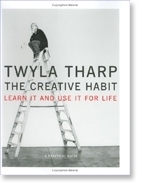Readers! Writers! Here's a how-to unlike any you've ever read: The Creative Habit

I rarely write reviews but want to make an exception for a book called THE CREATIVE HABIT by the choreographer Twyla Tharp. Writers, those who want to write, artists, dancers and "everyday people" will find help and inspiration in its pages.An elegant book physically, pleasing to the eye and the hand, THE CREATIVE HABIT is generous, authoritative, intelligent and well written. Each page brims with practical advice, specific how-to’s, questionnaires and exercises about how to:
open your mindovercome feardeal with failuredefeat distractionclarify your thinking
Ms. Tharp offers valuable advice, based on her own experience about how make your way through confusion and had to find solutions when you know something’s wrong but don’t even know quite what the problem is—the last an issue that regularly comes up, at least for me, in the course of writing a book.Using a wide-ranging set of examples ranging from Homer to Proust, from Ulysses S Grand to Ludwig Wittgenstein and Pope LeoX, from Merce Cunningham and George Balanchine to Ansel Adams, Raymond Chandler, Mozart and Yogi Berra, TCH offers a detailed road map how to define your creative identity. Practical, down to earth and never flinching from the daily nitty-gritty, Ms. Tharp explains the importance ofroutineritualsetting goalshow to know the difference between a good idea and a bad idea
She also addresses the common, but difficult dilemma facing creative people who must recognize ruts when they’re in one and she offers explicit guidelines about how to get out of them.Of special interest to baby boomers (and we're all going to be there one day!) is her candid description of the impact of aging—in her case particularly significant since, as a dancer and choreographer, her life is all about physical expression and movement. She talks about her recognition of the decrease in stamina, the need to set new challenges and explains how she turned the same brutal honesty on herself that she relies on to guide her dancers.She tells how she changed her approach and work habits when, moving through her fifties, she recognizes she isn’t the same dancer she’d been twenty years before and confronts the need to change. She describes what, specifically, she did to make the transition from habits that had served her well for two decades to establishing new approaches that turned the reality of aging into an absorbing challenge.You will find out about the value of “doing a verb” and about building a bridge to the next day, about the relationship between failure and success, the miracle of second chances and what to do when denial is no longer an option. It is hard for me to imagine anyone who won’t learn from or be inspired by a book that is part memoir, part manual, part how-to.
Published on May 16, 2013 05:02
No comments have been added yet.



